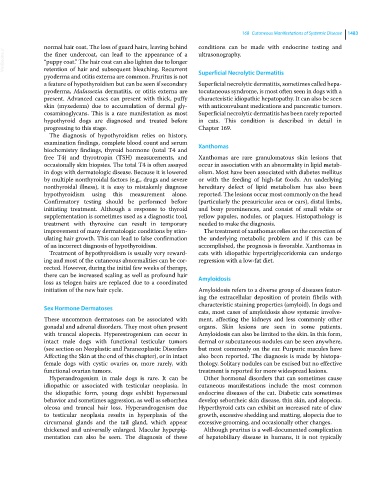Page 1545 - Clinical Small Animal Internal Medicine
P. 1545
168 Cutaneous Manifestations of Systemic Disease 1483
normal hair coat. The loss of guard hairs, leaving behind conditions can be made with endocrine testing and
VetBooks.ir the finer undercoat, can lead to the appearance of a ultrasonography.
“puppy coat.” The hair coat can also lighten due to longer
retention of hair and subsequent bleaching. Recurrent
pyoderma and otitis externa are common. Pruritus is not Superficial Necrolytic Dermatitis
a feature of hypothyroidism but can be seen if secondary Superficial necrolytic dermatitis, sometimes called hepa-
pyoderma, Malassezia dermatitis, or otitis externa are tocutaneous syndrome, is most often seen in dogs with a
present. Advanced cases can present with thick, puffy characteristic idiopathic hepatopathy. It can also be seen
skin (myxedema) due to accumulation of dermal gly- with anticonvulsant medications and pancreatic tumors.
cosaminoglycans. This is a rare manifestation as most Superficial necrolytic dermatitis has been rarely reported
hypothyroid dogs are diagnosed and treated before in cats. This condition is described in detail in
progressing to this stage. Chapter 169.
The diagnosis of hypothyroidism relies on history,
examination findings, complete blood count and serum Xanthomas
biochemistry findings, thyroid hormone (total T4 and
free T4) and thyrotropin (TSH) measurements, and Xanthomas are rare granulomatous skin lesions that
occasionally skin biopsies. The total T4 is often assayed occur in association with an abnormality in lipid metab-
in dogs with dermatologic disease. Because it is lowered olism. Most have been associated with diabetes mellitus
by multiple nonthyroidal factors (e.g., drugs and severe or with the feeding of high‐fat foods. An underlying
nonthyroidal illness), it is easy to mistakenly diagnose hereditary defect of lipid metabolism has also been
hypothyroidism using this measurement alone. reported. The lesions occur most commonly on the head
Confirmatory testing should be performed before (particularly the preauricular area or ears), distal limbs,
initiating treatment. Although a response to thyroid and bony prominences, and consist of small white or
supplementation is sometimes used as a diagnostic tool, yellow papules, nodules, or plaques. Histopathology is
treatment with thyroxine can result in temporary needed to make the diagnosis.
improvement of many dermatologic conditions by stim- The treatment of xanthomas relies on the correction of
ulating hair growth. This can lead to false confirmation the underlying metabolic problem and if this can be
of an incorrect diagnosis of hypothyroidism. accomplished, the prognosis is favorable. Xanthomas in
Treatment of hypothyroidism is usually very reward- cats with idiopathic hypertriglyceridemia can undergo
ing and most of the cutaneous abnormalities can be cor- regression with a low‐fat diet.
rected. However, during the initial few weeks of therapy,
there can be increased scaling as well as profound hair Amyloidosis
loss as telogen hairs are replaced due to a coordinated
initiation of the new hair cycle. Amyloidosis refers to a diverse group of diseases featur-
ing the extracellular deposition of protein fibrils with
characteristic staining properties (amyloid). In dogs and
Sex Hormone Dermatoses
cats, most cases of amyloidosis show systemic involve-
These uncommon dermatoses can be associated with ment, affecting the kidneys and less commonly other
gonadal and adrenal disorders. They most often present organs. Skin lesions are seen in some patients.
with truncal alopecia. Hyperestrogenism can occur in Amyloidosis can also be limited to the skin. In this form,
intact male dogs with functional testicular tumors dermal or subcutaneous nodules can be seen anywhere,
(see section on Neoplastic and Paraneoplastic Disorders but most commonly on the ear. Purpuric macules have
Affecting the Skin at the end of this chapter), or in intact also been reported. The diagnosis is made by histopa-
female dogs with cystic ovaries or, more rarely, with thology. Solitary nodules can be excised but no effective
functional ovarian tumors. treatment is reported for more widespread lesions.
Hyperandrogenism in male dogs is rare. It can be Other hormonal disorders that can sometimes cause
idiopathic or associated with testicular neoplasia. In cutaneous manifestations include the most common
the idiopathic form, young dogs exhibit hypersexual endocrine diseases of the cat. Diabetic cats sometimes
behavior and sometimes aggression, as well as seborrhea develop seborrheic skin disease, thin skin, and alopecia.
oleosa and truncal hair loss. Hyperandrogenism due Hyperthyroid cats can exhibit an increased rate of claw
to testicular neoplasia results in hyperplasia of the growth, excessive shedding and matting, alopecia due to
circumanal glands and the tail gland, which appear excessive grooming, and occasionally other changes.
thickened and universally enlarged. Macular hyperpig- Although pruritus is a well‐documented complication
mentation can also be seen. The diagnosis of these of hepatobiliary disease in humans, it is not typically

